 |
Balancing the Elements of ConsultancyRichard Veryardveryard projects > demanding change > balance > chinese |
 |
Balancing the Elements of ConsultancyRichard Veryardveryard projects > demanding change > balance > chinese |
| Balance | Five elements | Discussion |
| An enterprise may be balanced or unbalanced. (This
may apply to an organization, a project, a professional practice, or a
social institution.)
An unbalanced enterprise may be dysfunctional. (An obsessively balanced enterprise may also be dysfunctional.) An intervention may attempt to restore a healthy balance, or may attempt to disrupt an unhealthy balance. On this page, we discuss a model of balance derived from ancient Chinese thought. |
Fire represents drive or purpose.
Earth represents the raw material, networking, social infrastructure. Metal represents formal structure. Water represents creativity and insight. Wood represents planned activity. |
Each element has its own characteristic
way of being.
The five elements can be arranged into a sphere. The five elements must be in (dynamic) balance. Consequences for client intervention. |
![]()
To counteract this tendency, when we describe an enterprise culture or practice, there are five things we want you to know about.
It turns out that these five things correspond to the
five ‘elements’ of ancient Chinese wisdom: fire, earth, metal, water and
wood. So we shall use this metaphor as a memory-jogger.
Fire represents drive or purpose.Earth represents the raw material.Metal represents formal structure.Water represents creativity and insight.Wood represents planned activity. |
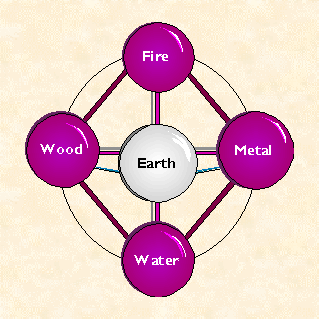 |
Why does anyone want to do this?
|
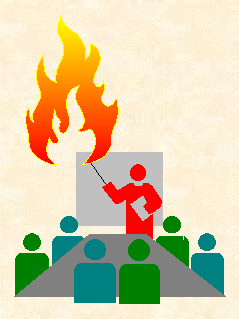 |
| What kind of material do we work with?
What generates the problems that sustain what we’re trying to do? What relationships (or transference) do we need to support productive work? |
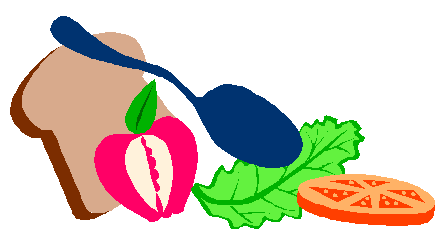 |
| What tools and disciplines are available to support the task?
Does the same formality apply to different scales?
What are the boundaries of what we do? What is the internal structure (‘metamodel’)? |
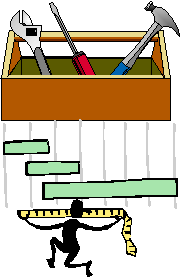 |
| How do we understand what is going on?
And what is not going on? How do creative processes interact and flow with the planned activity? How do we recognize, respect and respond to creative insight? 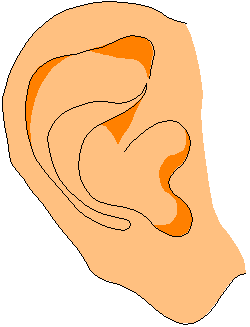 |
|
| What plans, decisions and tasks do we undertake?
What products and services do we deliver (and invoice for)? How do we transform the raw material into something useful? What skills and powers do we require?  |
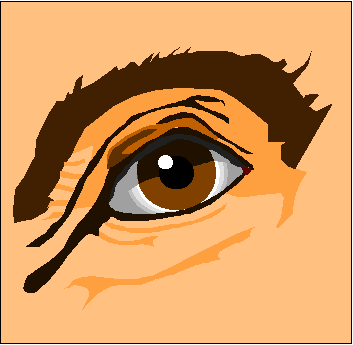 |
|
|
|
|
|
|
|
|
|
|
|
|
|
|
|
|
|
|
|
|
|
|
|
|
|
The inner core is water - unconscious process Centrifugal force is wood - task focus The surface is fire - presentation & energy The axis is earth - client relationships Centripetal force is metal - formal structure
|
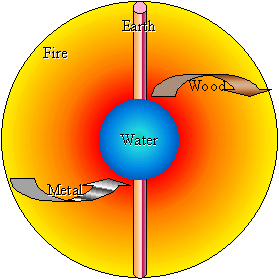 |
| The curved black arrows denote support.
The straight purple arrows denote counterbalance or control. A stable and effective organization combines all five elements in (dynamic) balance. |
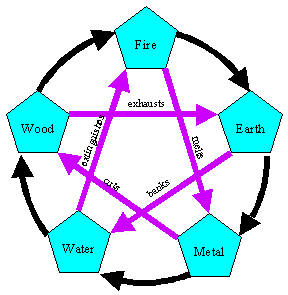 |
An intervention may emphasize one or two elements.
Where the client is weak on one element, the intervention should emphasize the supporting element.
The consultant is often tempted to do this, either because it seems necessary (at least in the short term) in order to meet objectives, or because it might lead to long-term dependency.
But beware: this is a highly unstable situation. The missing role will often prove remarkably difficult to perform, even (or especially) for a consultant with an excellent track record in this role elsewhere. In the unlikely event that the consultant is successful, this may disrupt the client system enough to force a change; but such disruption usually results merely in the consultant being thrown out. So much for long-term dependency.
Often you find out later that the client has had a series of consultants playing this role, with an unhealthy cycle of seduction and rejection. You were just another mug.
We found that they were pretty good in networking and support (earth). They seemed to find it impossible to actually get anything done (wood).
They obviously wanted us to do all the work for them (wood). But at the same time, they would have been profoundly threatened if we had succeeded.
Not primarily because this would have shown up their weaknesses. They fancied themselves as managers: so if we had got lots of work done, they would have taken the credit for delegating the work to us.
But the real problem was that the work would have undermined their carefully constructed relationships with everyone else. There seemed to be no way the work could have been done without upsetting some people, putting pressure on others, and generally raising the temperature.
The key to a successful intervention in this situation was creativity (water). We needed all the creativity we could access, to build up the capability to do work, both for us and for the client, without threatening the client's position. The client's networking and support strengths meant that the creativity was grounded, but not eliminated.
We found an overwhelming task-oriented culture (wood). What they lacked was the ability to understand (water) the implications of what they were doing.
My belief is that they hired us because they recognized that we could bring a much-needed creative understanding (water). But in this context, the creativity of some members of the consultancy team caused some mutual discomfort and resistance.
Other members of the consultancy team got seduced by the client culture, and advocated a highly task-oriented approach to the intervention. For a while, the conflict and lack of balance in the client organization was echoed within the consultancy team.
The key to a successful intervention in this situation was discipline (metal). Fortunately, we had a well-articulated risk management methodology, which provided a clear structure for the work. In due course, we were able to hand responsibility for running the programme over to an internal director, who was better able to deploy the networking and political resources to support the necessary disciplines.
You may sometimes be able to support yourself. So it is often okay for the same person to own both ends of a black arrow.
But it is very difficult to counterbalance yourself. So it is usually inappropriate for the same person to own both ends of a purple arrow.
This means that an effective and stable team needs between 3 and 5 members.
| For a good introduction to the five elements of Chinese thought ... | Harriet Beinfield & Efrem Korngold, Between Heaven and Earth. New York: Ballantine Books ISBN 0-345-37974-8 |  |

|